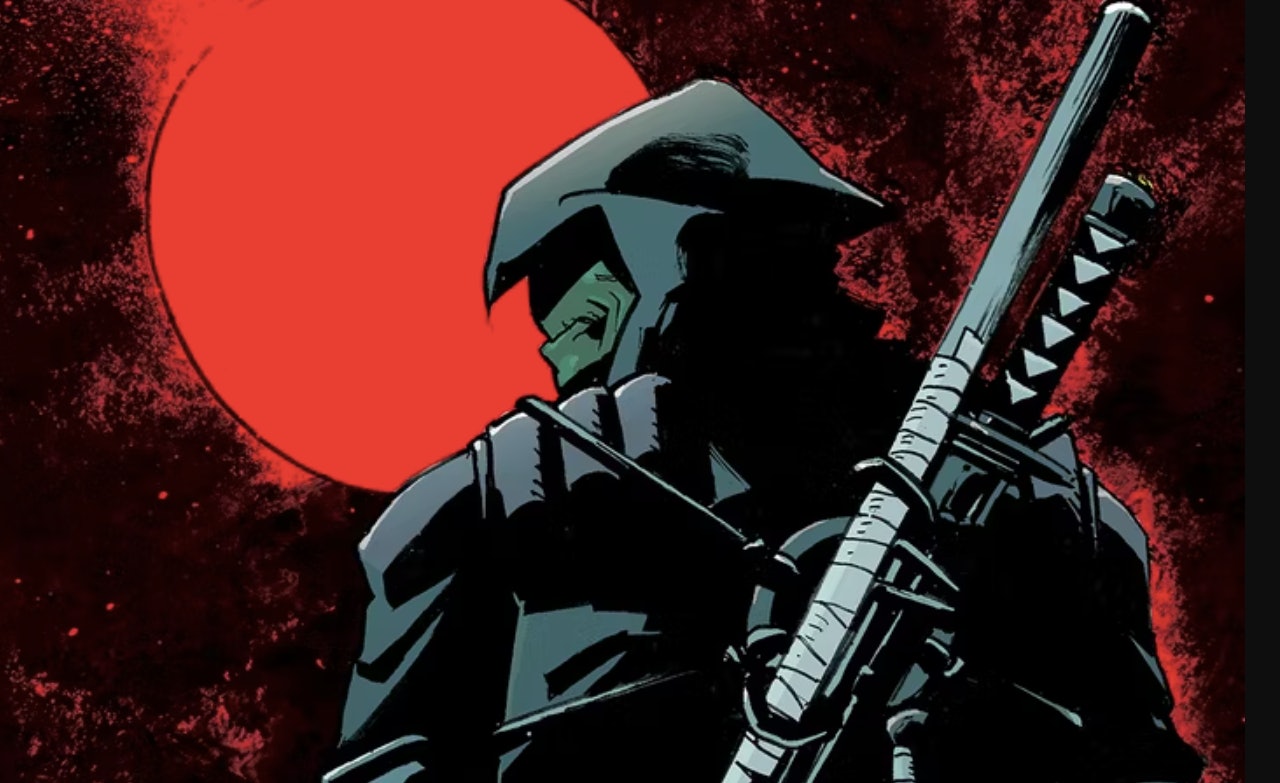
It was always going to be Michelangelo.
In 1984, when Kevin Eastman and Peter Laird first goofed around about the idea of a turtle wielding ninja weapons, they started by drawing a turtle with nunchucks, which officially makes Michelangelo the “firstborn” Teenage Mutant Ninja Turtle. So, more than 30 years later, when Eastman was looking to tell the story of the last surviving Ninja Turtle, he always knew it was Michelangelo. For the public, however, the identity of the last surviving member of the Heroes in a Half Shell would remain a mystery for six months.
The five-part series The Last Ronin was announced by IDW comics on April 27, 2020. In the press release, Eastman explains this was a story he and Laird first plotted out back in 1987 when they were fewer than a dozen issues into their comic book and the original Teenage Mutant Ninja Turtles cartoon was months away from premiering. He also provided a sneak peek at the artwork of the first issue, drawn by Andy Kuhn, which featured an aged Ninja Turtle wielding all four of the TMNT’s signature weapons and wearing a black mask.

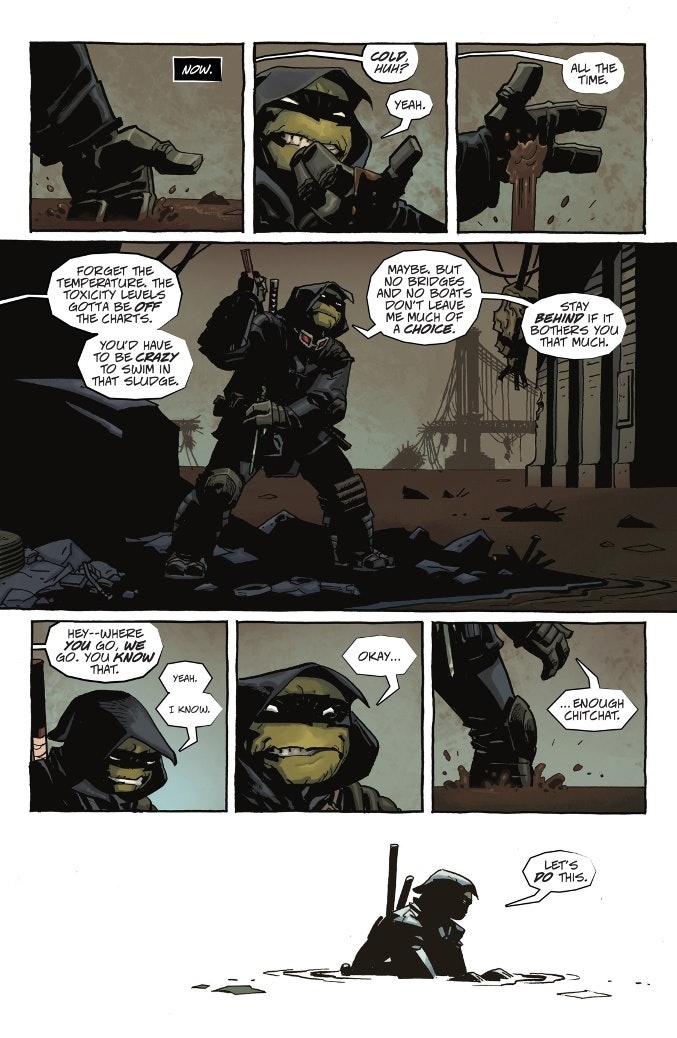
For the next six months, fans debated who was hiding behind that mask. Eastman and the team kept silent, building the buzz for a first issue that arrived on Oct. 28, 2020. Its final page revealed Michelangelo as the last turtle standing.
The gambit worked. The Last Ronin was a monster hit, entering into a second and third printing almost immediately, with an eventual fourth and fifth printing to follow. Over the next 18 months, the four remaining issues came out at a sometimes maddeningly slow pace, though not without good reason. Between the pandemic, a global shipping crisis, Diamond Distributors temporarily shutting down the comic book industry, the loss of The Last Ronin’s original penciler, and Eastman’s dogged desire to make sure he got everything perfect, the series didn’t conclude until April 27, 2022, two years to the day after its original reveal.
Despite the delays, the response was near-universal praise. Old-school TMNT fans were delighted to have a gritty story that once again felt like the classic Mirage comics, and more casual fans were surprised to see something from their childhood covered with such thought, care, and grit. It seemed that, despite everything, The Last Ronin was worth the wait, which was especially gratifying to Eastman and the rest of the team at IDW comics, who join us here at Inverse for the exclusive oral of The Last Ronin.
“Funky Story Ideas”
Kevin Eastman (co-creator of the Teenage Mutant Ninja Turtles, writer and layout artist on The Last Ronin): Since 2011, [writer] Tom Waltz and I had been working on IDW Teenage Mutant Ninja Turtles. Around 2018, we were looking down the road towards Issue #100 and we knew where that story was going, so we began to look past Issue #100 and we asked ourselves, “Where do we go from here?” A lot of ideas were thrown around at that time and I said to Tom, “I’ve got this idea that Peter Laird and I wrote 31 years ago.”
Back in 1987, Pete and I were wrapping up Issue #11 of the original comics, and we asked ourselves that same question: “Where do we go next?” We thought, “Let’s look 30 years down the road, to where the Turtles are then.” We started to make all these notes about what the world would be like and what had happened throughout that time period. We came up with about a 20-page, typed-up document that Pete did, plus about 20 to 25 handwritten pages that I did.
It wasn’t called The Last Ronin yet — that came from me later when Tom and I dusted it off — but Pete and I thought it might be the “final” Turtles story and that would give us sort of a lighthouse to navigate towards. But this was also when the Turtles were really taking off with the toys and the cartoon, so this idea got pushed to the side until I found it years later in a folder labeled “Funky Story Ideas.”
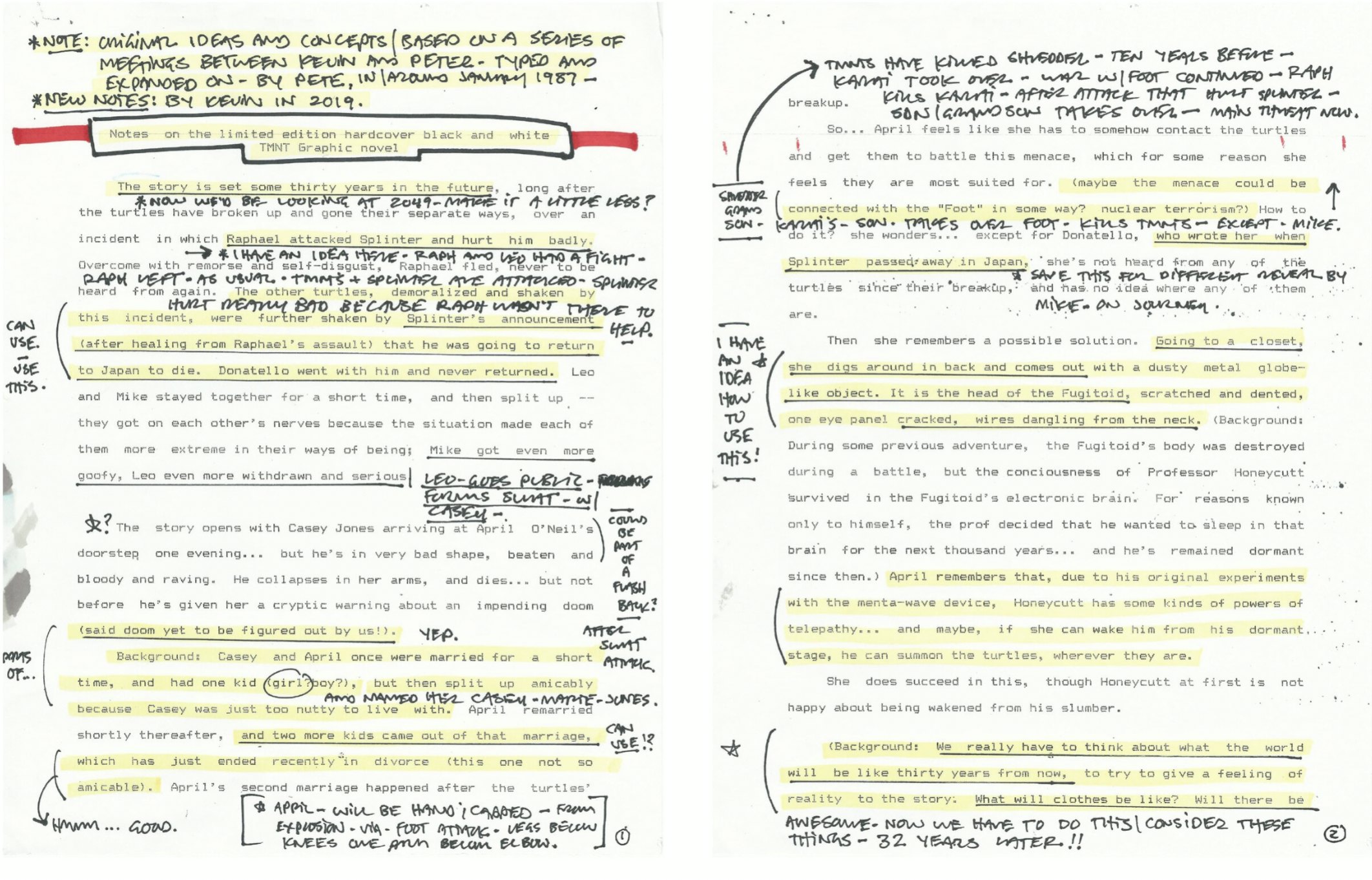
Fast forward to 2018, I told Tom about this idea. I made notes on the pages Peter had typed out and spent maybe six months typing up what I thought was a good arc based on those original notes. I also checked in with Pete and told him, “This is what I’d like to do. I’d love to have any and all comments.” Pete wrote back with a couple of small comments, but he said to me, “This sounds interesting. Have fun with it.” He also added, “Maybe I’ll read it in the end. Maybe I won’t.” That’s all Pete. He’s always been very direct. Honestly, I still don’t know if he’s read The Last Ronin.
About six months after first mentioning this to Tom, I came back to him with my outline and everything else and he just fell in love with it and that was the genesis of The Last Ronin.
Developing the story
Tom Waltz (writer on The Last Ronin): It was amazing to me just how prescient Peter was about the future. He flip phones in there and he was totally on point about how big a part cellphones would play in our lives, and this was in 1987! But, just like how Blade Runner is set in 2019 — which has come and gone — this Turtles story was originally set in 2017, so we had to make a new future for The Last Ronin.
Eastman: To create our version of the future, a lot of different pop culture influences went into it. I’ve always loved the futuristic visions from Heavy Metal magazine by people like Enki Bilal and Mœbius, as well as the Harry Canyon sequence in the 1981 Heavy Metal movie. Along with those, we pulled from The Fifth Element, Blade Runner, and some elements of Terminator.
Waltz: There was also a lot of discussion about timelines. Originally, this was going to be a conclusion of the Mirage universe — the one that Kevin and Peter created back in 1984 — but, as we started working on it, that began to box us in. One of those roadblocks was the character of Casey Marie Jones, April O’Neil and Casey Jones’ daughter. She didn’t exist in the Mirage universe, but we knew we wanted her to carry on the legacy after Michelagelo died.
Also, we wanted the story to be about a blood feud, just like the original comic. So, we wanted the new Shredder to be the grandson of the original Shredder and the son of Karai, but Karai wasn’t Shredder’s daughter in that original continuity. We also, as we were writing, got more and more story ideas for The Last Ronin sequels and prequels that we could do later. So, it just made sense to make The Last Ronin its own thing.
We still wanted to include a lot of Peter Laird in this story, even if he wasn’t directly involved. The inclusion of Fugitoid was part of that, as that character is very indicative of Peter. Plus, much of that original outline was the backbone of our story.
Eastman: In the original outline, Michelangelo was not specifically named as the remaining turtle, but from the word “go,” I knew he was the one. Not only was he the firstborn, but he was the one that had the furthest to go for a character arc.
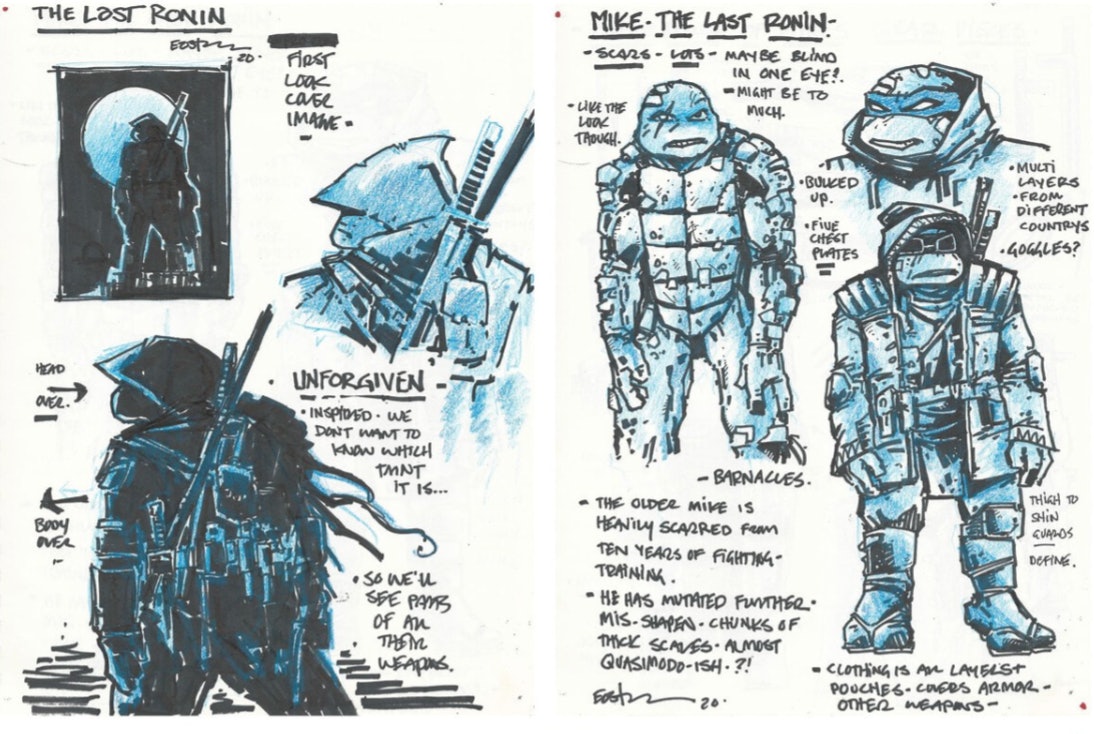
Waltz: We had a number of discussions about the color of the headband, too. While black was the natural choice, we hesitated a little because the character Slash has a black bandana. We also considered white, orange, and even the red from original comics, but that would have made everyone think it was Raphael. Eventually, we ended up with black as sort of a mourning band.
Eastman: We wanted to give the fans something special. That’s why it’s an oversized format similar to the original Mirage comics, and that’s why we wanted larger issues at 40 pages. I wanted to be able to do a 15-page fight scene, which you can’t do in a 22-page comic.
Waltz: Once we figured out the story, Kevin and I brought it to IDW. They were very excited, and Nickelodeon was very excited. We got moving right along, and there weren’t a lot of hurdles at first. Little did we know, right around the bend, there were a lot of them waiting for us.
Assembling the team
Andy Kuhn (original penciler on The Last Ronin): I had done a lot of work on Teenage Mutant Ninja Turtles for IDW, and months before The Last Ronin began production, I was approached by Kevin Eastman about doing a story about the last surviving Ninja Turtle. I thought it sounded very cool and told him I was interested, but there was a long time between when he approached me and when it was actually going to get made. Finally, we went into 2020 and The Last Ronin was going to be my thing for the year.
We started working on it, and shortly into 2020, the pandemic began. I didn’t realize it was going to have such a serious effect on me. In addition to the logistical difficulties, I had a death in the family and I had to travel for an operation. It was a really rough time and I just wasn’t able to do the work on the schedule they needed. Eventually, they needed to get somebody else to do the job, which I totally understand. I was in a bad place and I still have a fair amount of shame about it. I’ve been drawing comics professionally for over 20 years, and this was the biggest project I was ever hired to do and I was unable to do it. For a long time, I seriously feared my work in comics was done. Over the past few months, I’ve finally pulled myself out of that, but I’m still kicking myself about it.
Bobby Curnow (editor on The Last Ronin): I always felt bad about that. I consider Andy a pal, and he’s a super talented artist, but when he ended up not working out, then Kevin knew the Escorza brothers from some work they did on Heavy Metal magazine, which Kevin has been involved with for years. So we ended up going with them.
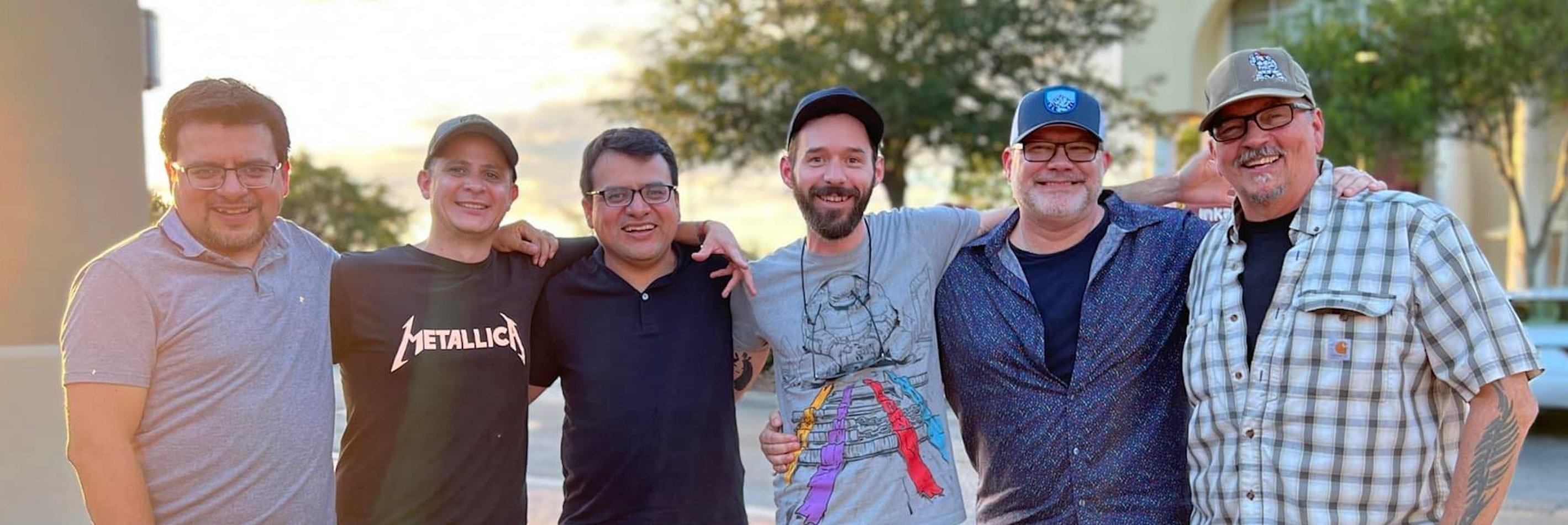
Isaac Escorza (artist on The Last Ronin): Actually, it was Courtney Eastman, Kevin’s wife, who recommended us. We had met them four years earlier at a convention in Mexico, and when Kevin needed to replace Andy Kuhn, Courtney suggested us, which we are very grateful for.
Esau Escorza (artist on The Last Ronin): As soon as we got hired, we had to draw the first 20 pages in record time because we had to re-do what was done by Andy Kuhn. We tried to emulate some of what Andy already did, but in our own style. In addition to that, for this vision of the future, Mœbius was an influence because Kevin is a big fan of Mœbius. As for Michelangelo’s look — which was designed by Kevin — Frank Miller’s The Dark Knight Returns was an important influence.
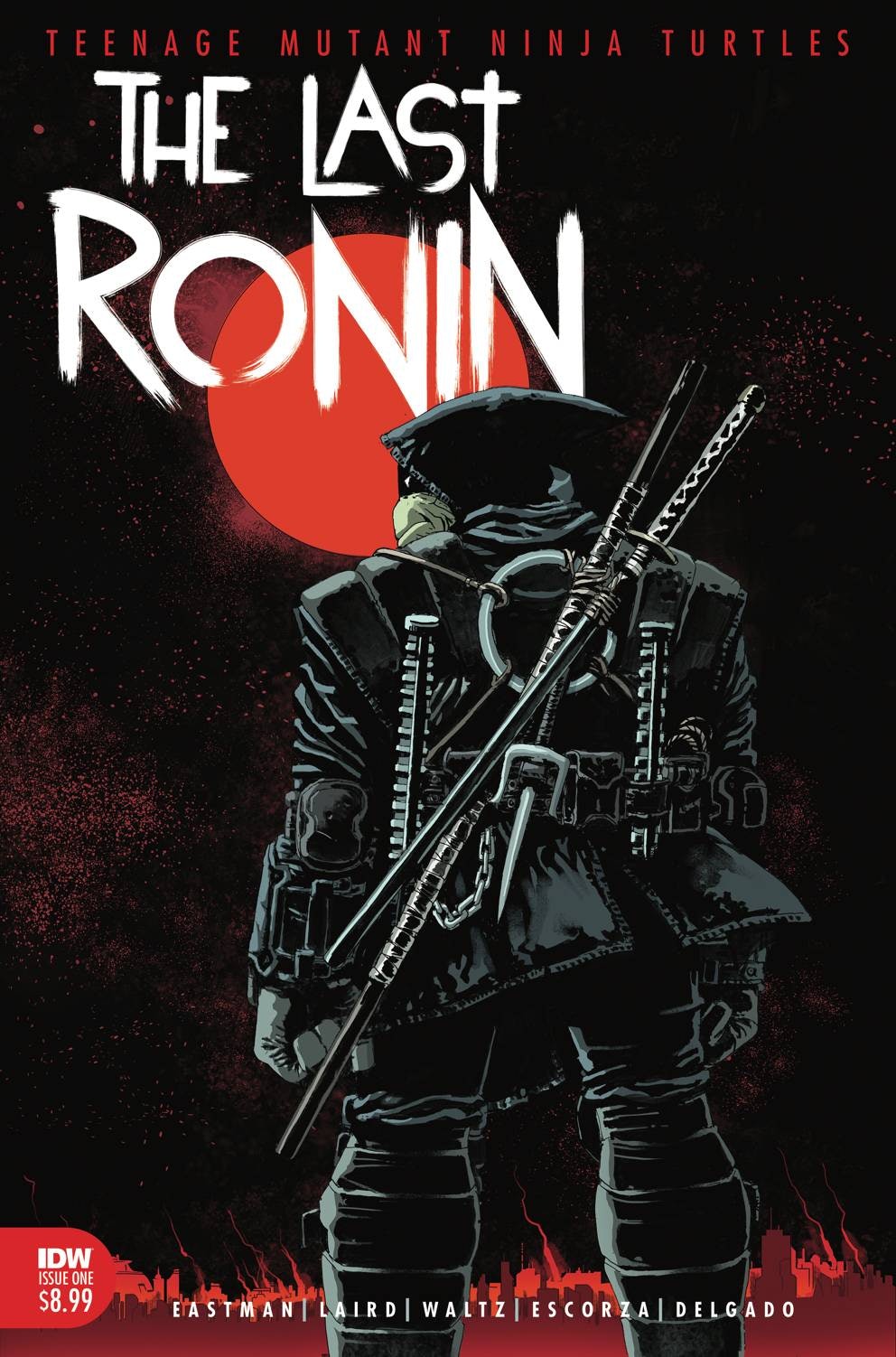
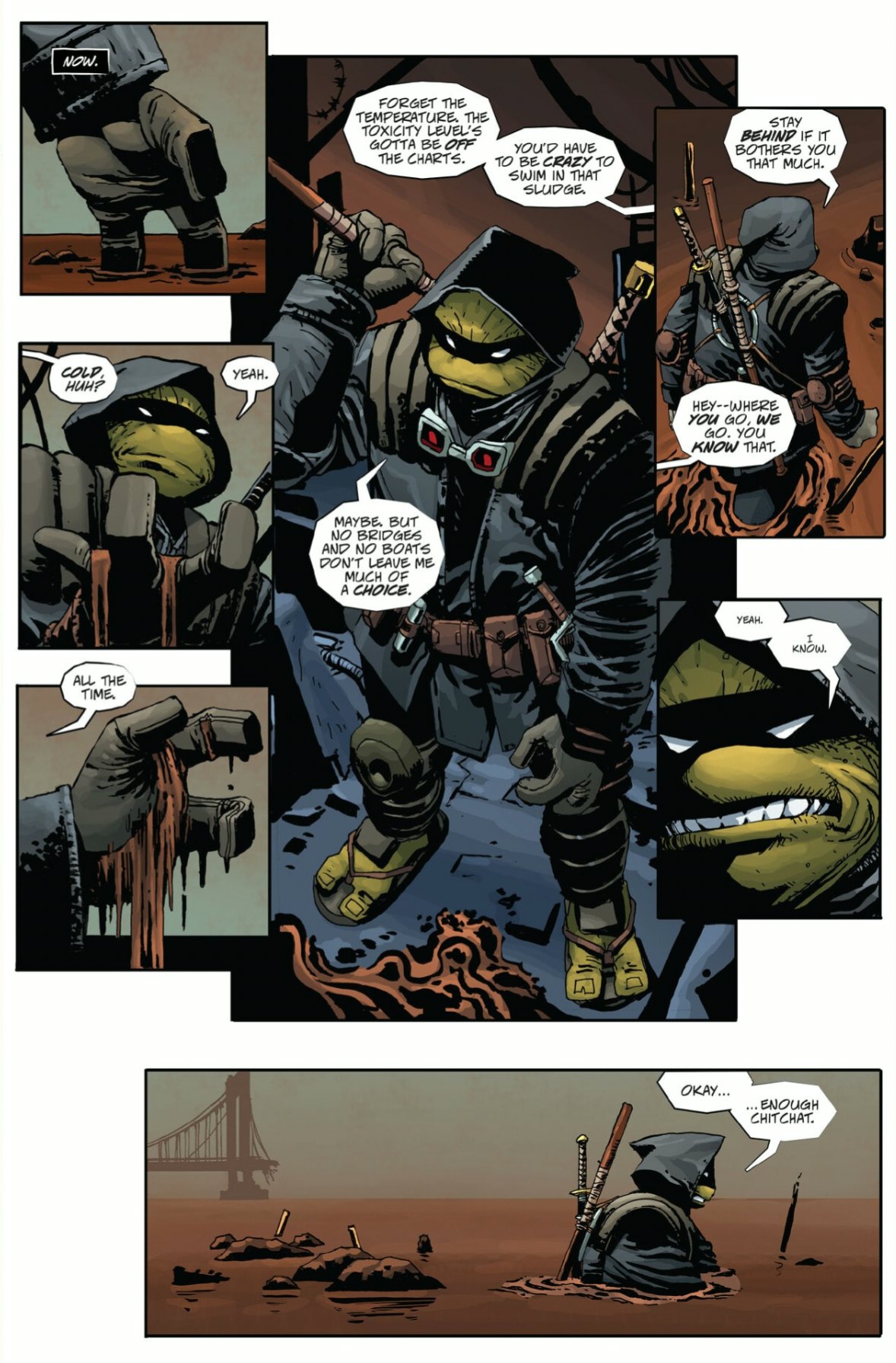
Ben Bishop (artist on The Last Ronin): I was not on the original team for The Last Ronin. I’ve worked a lot with Kevin Eastman on things like Raphael: Target R and Drawing Blood, but for The Last Ronin, it was just a comic that I was excited to read someday. But with the pandemic and everything, Kevin explained to me that Andy might need a hand, and eventually, he told me that he wanted me to do the flashback stuff in the series, covering the events before The Last Ronin, which would include the deaths of the three other Turtles, Splinter, and Casey Jones. In other words, I would be the one to pull the trigger on all these characters.
For a little while, I was on the book with Andy. Then, when he dropped out, Courtney was in my corner to do the whole thing. I even did some samples for the future stuff, using a brushed ink, chunkier style because I knew Kevin wanted to harken to The Dark Knight Returns. But I don’t really have that style. I have thin lines and I draw everything with a mechanical pencil, so I wasn’t quite right for that. So Kevin decided to go with the Escorza brothers, and it’s so much better that way because you really feel like you’re in a different time period when it switches from the past to the future.
But, even in my flashback scenes, I had to adjust my style a little bit. At first, I was drawing the Turtles with the gumdrop-like heads they normally have in the IDW comics, but Kevin wanted me to go wider and wider. Eventually, I decided that I was drawing aged-up Jim Henson suits from the first Teenage Mutant Ninja Turtles movie, and they’ve been at war for 40 years.

Waltz: How Kevin and I worked together on The Last Ronin was an interesting change for me. For 100 issues of Ninja Turtles, I’d been in the driver’s seat with Kevin riding shotgun, then we switched places for The Last Ronin. While it was still story-driven, once Kevin and I layed out a story, he did the layouts then we added the dialogue last, more like the “Marvel method” you hear about. There were also — between Kevin and me and Ben and the Escorzas — a lot of different elements. The glue that held it all together was the colorist, Luis Antonio Delgado — that guy is a machine.
Luis Antonio Delgado, colorist for The Last Ronin: Switching between the styles of the Escorza brothers and Ben Bishop was a really interesting challenge. For the Escorzas, who covered the stuff with Michelangelo in the future, Kevin referenced 1980s Daredevil comics by Frank Miller, as well as The Dark Knight Returns and Blade Runner. As for Ben Bishop’s flashbacks, the colors were less saturated and much softer, almost like pastels. I also added a bit of a filter to make it look like a flashback, which was Ben’s idea.
For all of this, Kevin Eastman played a big part in it. He had a very clear idea what he wanted when it came to the colors, just like every other aspect of The Last Ronin.
Issue #1: “Wish for Death”
Waltz: There was a lot to cover. In addition to setting up the world and the Last Ronin himself, we needed to introduce the device of Michelangelo talking to the ghosts of his three brothers. Kevin and I purposefully never decided if they were actual ghosts or if Mikey was crazy, hearing the voices in his head. But we knew we had to include that aspect because the banter between the four brothers is what makes a Turtles comic different.
We were also building up towards the seppuku scene at the end of the first issue, where Michelangelo is about to take his own life because he failed in his mission to kill the new Shredder. This scene was my big idea for the issue and I was really happy with how it turned out.

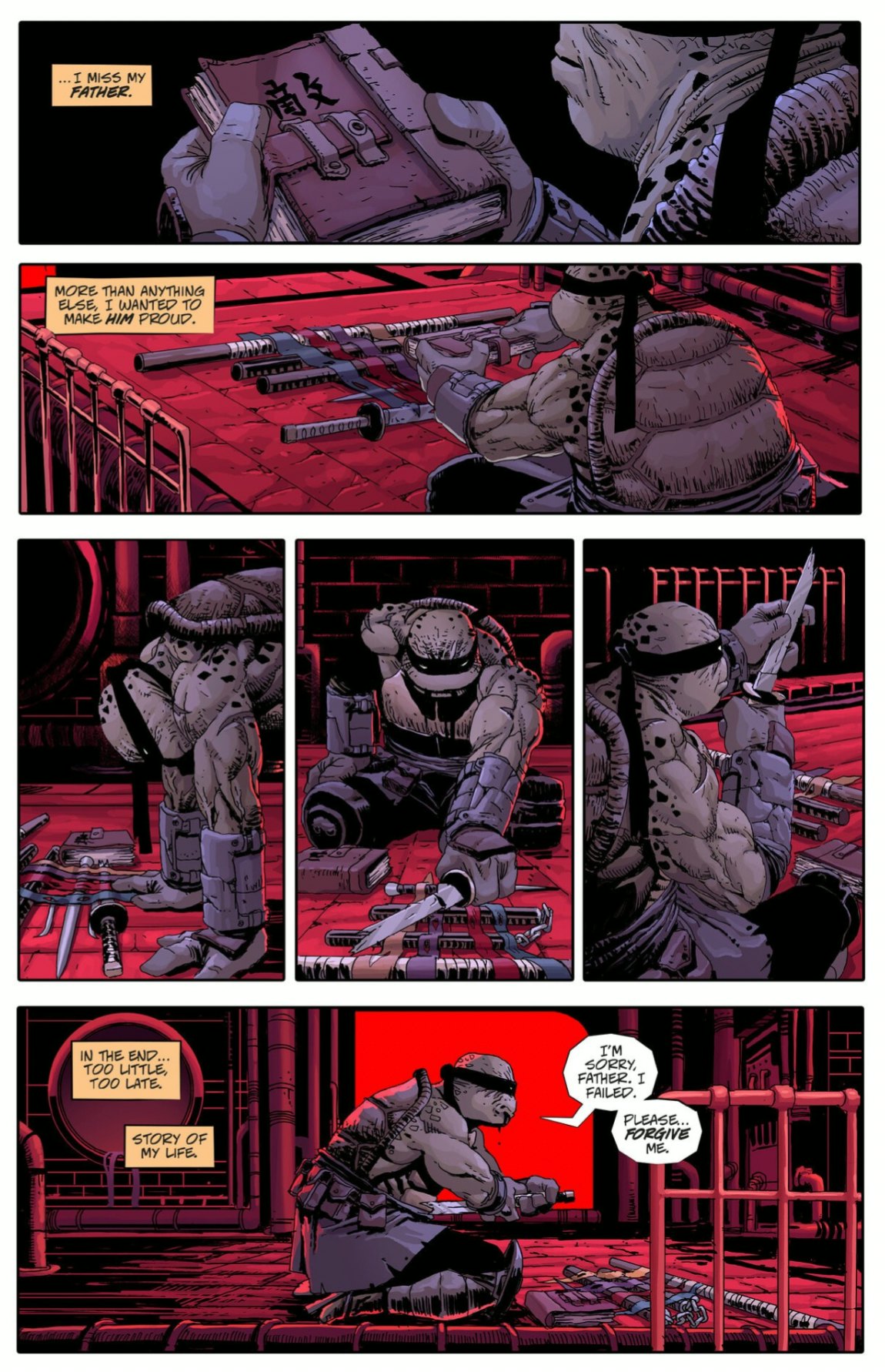
Eastman: Tom and I also decided that Michelangelo would be named on the last page of the first issue. We discussed not saying it at all in Issue #1, but to get the audience as invested in this character as we were, we thought it would make for a great “holy shit” moment, which would solidify their investment in the story.
Issue #2: “First to Fall”
Eastman: Issue #2 told the story of Raphael’s death. While every issue was about the death — or deaths — of the main characters, each death was handled with great purpose and intent. It had to be a building block in the story. With Raphael, after a long truce with the Foot, the Turtles were ambushed and Raphael reacted exactly how Raphael would react, with blood and vengeance.
Bishop: After the Turtles are ambushed and it looks like Splinter is going to die, Raphael runs off, fights a ton of Foot soldiers, then gets killed by Karai. Kevin wanted this to be a darker book. Since the book was already late, they couldn’t really scale back the violence too much because they needed to get it out. I took that right out of Kevin’s repertoire. He told me once, “If it’s too late, they won’t change anything.”
All they really changed was that they darkened the color of the blood to almost black and they removed the end of a sai that was stabbed through a guy. Everything else made it through, including a very small detail that, until now, I think only me and Luis know about. When Karai stabs Raphael in the throat, you can see a tiny glint of silver in Raph’s mouth — that’s the tip of Karai’s blade.
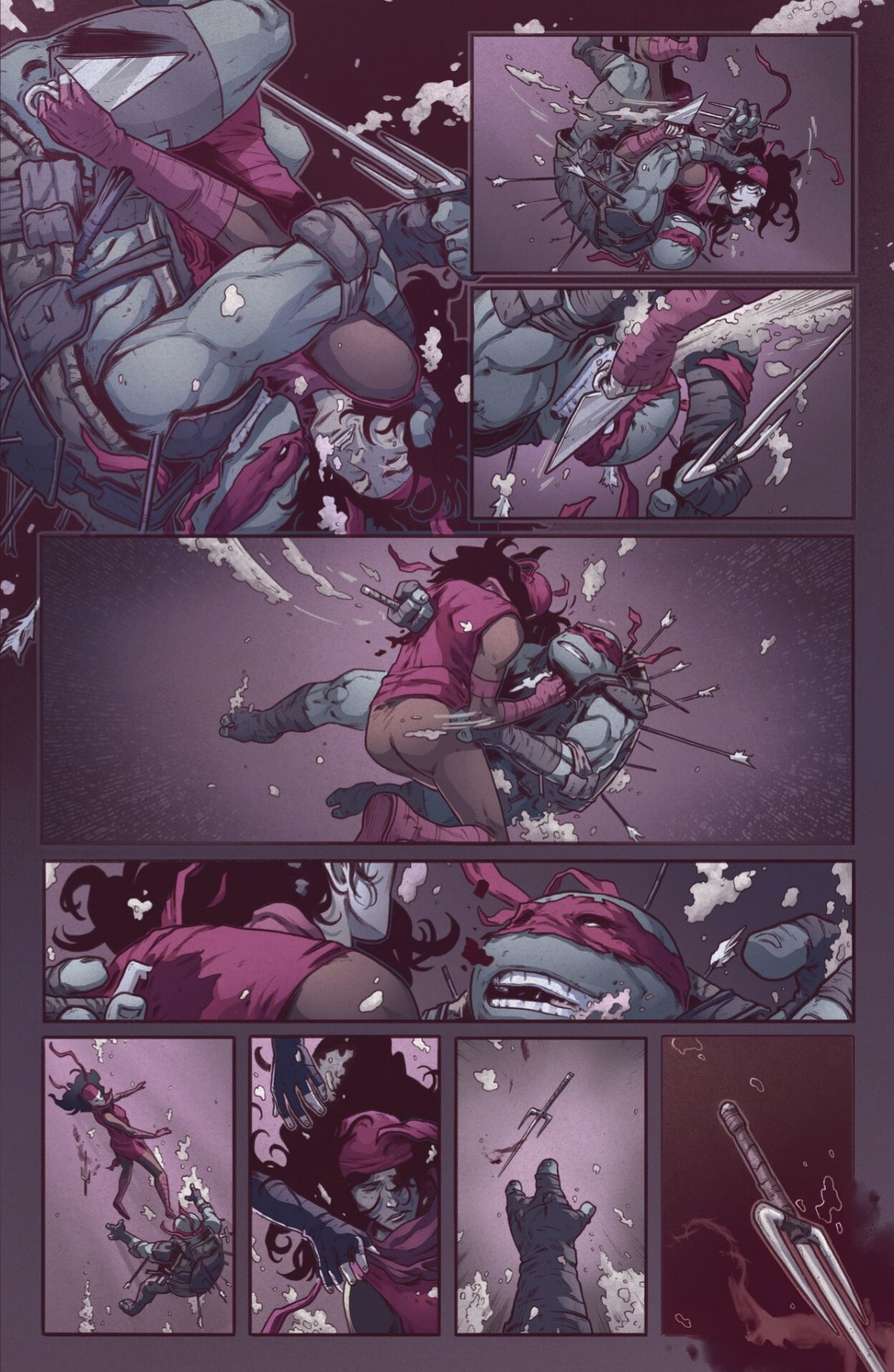

Delgado: The way Raphael died hit me the hardest. Leonardo and Casey Jones’ deaths were heroic. Donatello died protecting his father, which was beautiful. But Raphael died full of rage and hate. He ended up with a knife in his neck. It was brutal.
Issue #3: “Fight or Flight”
Eastman: Years after Raphael died, Leonardo and Casey Jones became the city’s last line of defense against the Foot. At the end, they’re fighting this huge onslaught of mousers and robotic Foot soldiers. They know it’s their last stand, but they go down fighting and joking about what kind of pizza they’re going to order later. I saw this as like the ending of Butch Cassidy and the Sundance Kid.


Waltz: For all of these deaths, we deliberately set them up so they were tragic and somewhat heroic, but they were also useless. We never wanted to glorify their deaths. Casey and Leo may have gone out in a blaze of glory, but they didn’t win — they got tricked into an ambush, and their death served no purpose. It was just a death, just like I could go outside and get hit by a bus.
Issue #4: “Blood in Snow”
Waltz: We also wanted to get into the history of the feud between Shredder and the Turtles, so we wanted Donnie and Splinter to go to Japan to broker peace between the Foot Clan and Hamato Clan. Some people have asked me, “Why would Donnie go to Japan with Splinter to die?” Well, because Donnie would fly the plane — it’s as simple as that. And, of course, Splinter’s plan to bring peace fails, and he dies. In the end, their deaths didn’t serve any real purpose, and that was the point. It’s just more and more fighting.
Bishop: For the final fight with Donnie and Splinter, Kevin said to me, “Remember when we saw Yoda kicking ass against Count Dooku? It’s going to be like that,” so I got to show Splinter beheading guys and doing stuff we’ve never seen before.

Waltz: I came up with the title, “Blood in Snow,” because I thought the image of them fighting in snow in Japan could offer some really beautiful, gruesome imagery. Also, I have always loved Boromir’s death in The Lord of the Rings: The Two Towers where the Orcs shoot him down with all the arrows. I suggested doing something like that for Donnie and Splinter’s death and Kevin put it together perfectly.
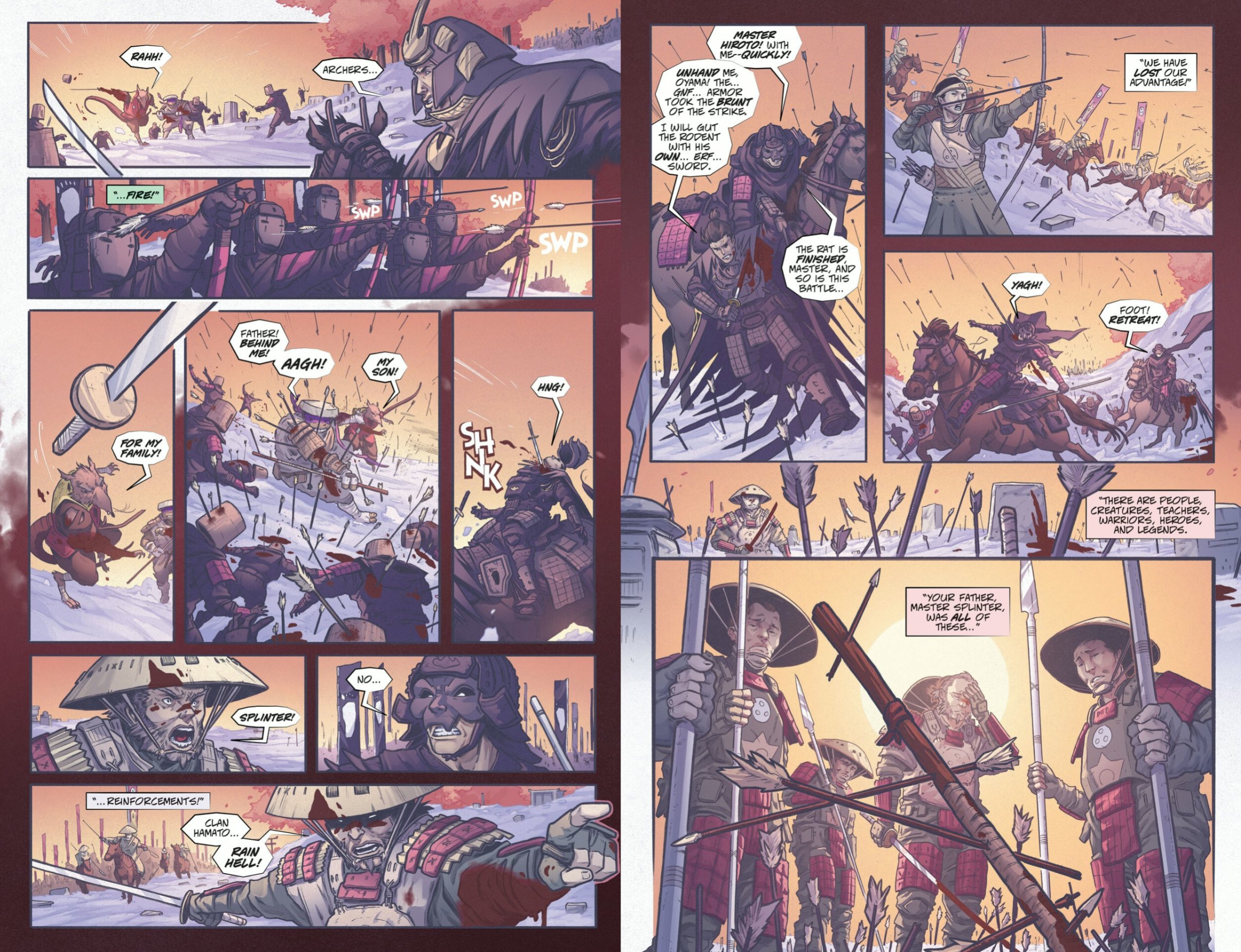
Issue #5: “The Last Ronin”
Waltz: We tried to make a lot of similarities between the first and fifth issues. In the first issue, he’s trying to shut up the voices of his brothers — who have been kind of berating him throughout — but he can’t do it until Issue #5. Also, when he’s heading into the final mission to kill Shredder, he’s finally able to accomplish his mission, not because he’s a better warrior, but because he’s found love and family again with April and Casey Marie. At the end, Michelangelo dies in the mud, fighting Shredder, but he finally knows peace because the feud is over.
Bishop: I saw one interpretation of the four Turtles’ deaths that I really liked. It said that the four Turtles died with all the different elements. Raph dies in the water, Leo dies in a fire, Donnie dies with the wind because of the arrows, and Mikey dies in the mud — Earth. I don’t know if Tom and Kevin did that on purpose, but it’s pretty brilliant either way.
Waltz: As far as I know, that was never intentional, but so many things have happened serendipitously over the years that I've worked on Ninja Turtles that maybe it is what the universe intended.
Isaac Escorza: Michelangelo’s death really surprised us. We did not know he was going to die. It was super emotional and it was an honor for me and Esau to get to draw it.
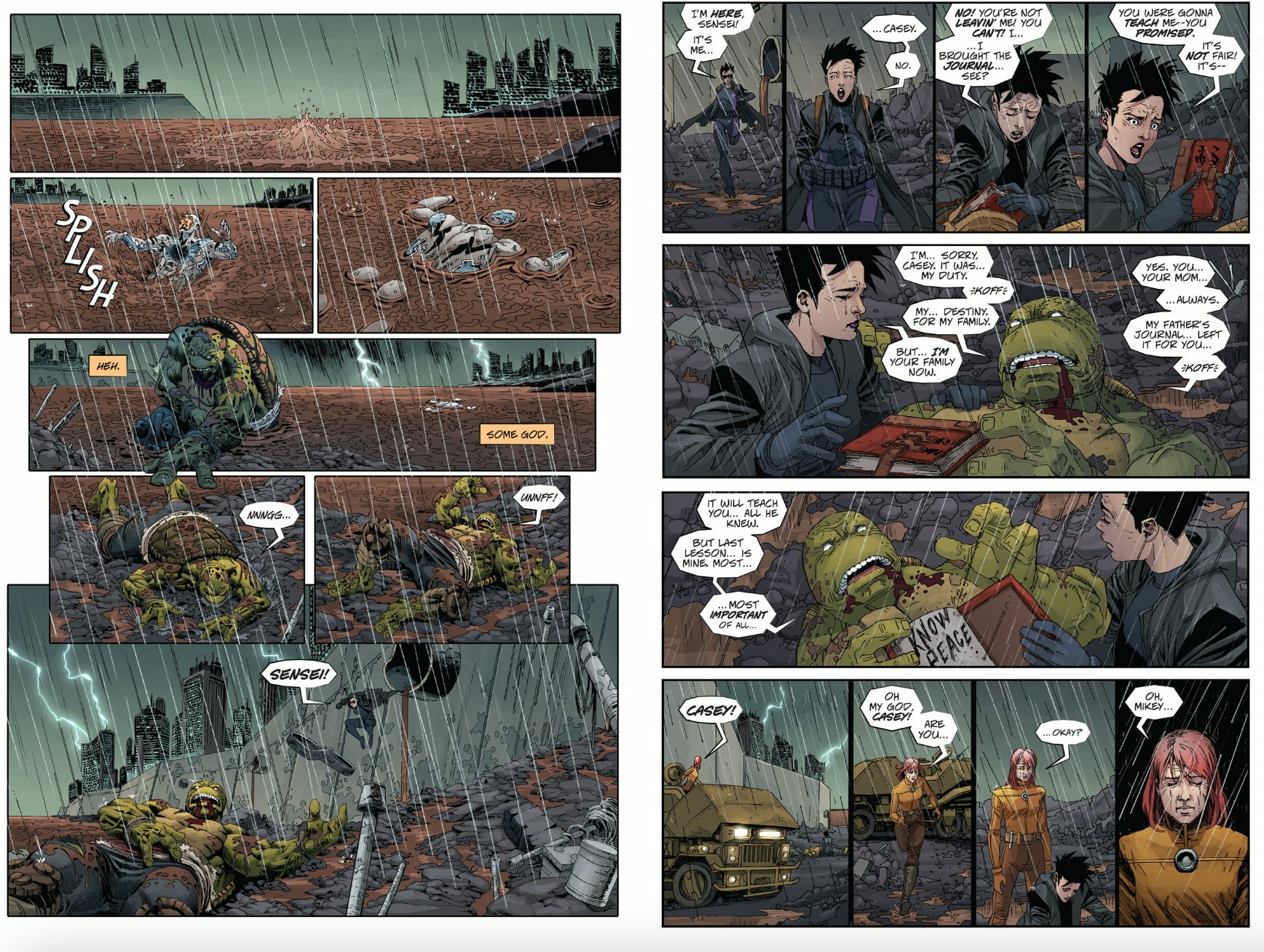
Eastman: Michelangelo was always going to die. One of the greatest graphic novels of all time is The Dark Knight Returns. It was brilliant, but if I could complain about it a little bit, I think Batman should have died at the end and passed on the baton. That’s what I wanted to do here, have Michelangelo pass on the baton to Casey Marie Jones.
In the end, all the characters Pete and I created, except for April, are gone at the end of The Last Ronin, which is exactly how I wanted it from the very beginning. And I wanted to show them reunited in Valhalla.
Bishop: For that final page I did, I got to show all the Turtles jumping on rooftops and making fun of each other. I also got to show them looking out at the sunset, as an echo to the end of the first movie with them on the top of the building. I knew how important this page was to Kevin, so I was probably more emotionally charged drawing that page than I’ve ever been drawing anything.
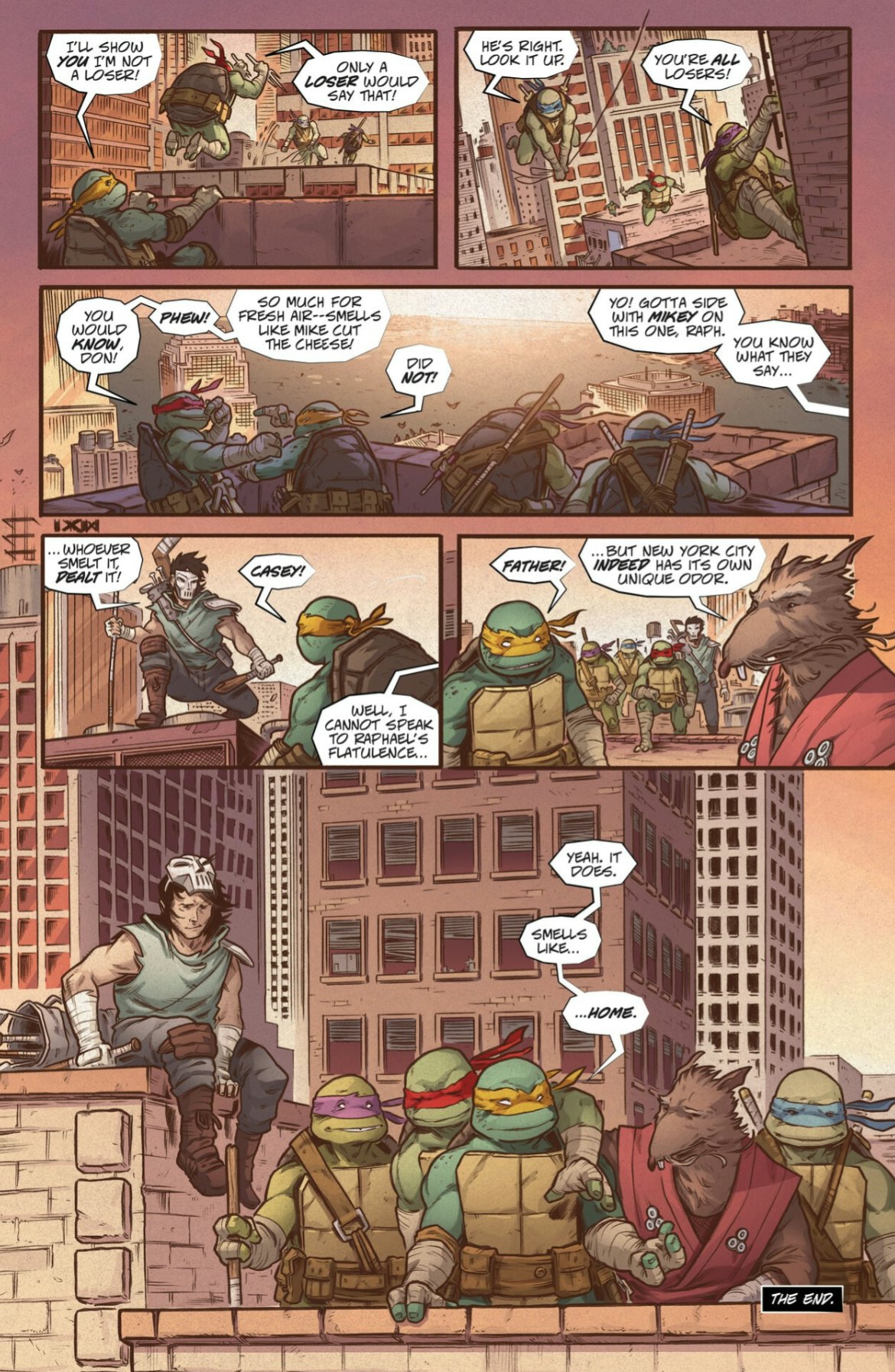
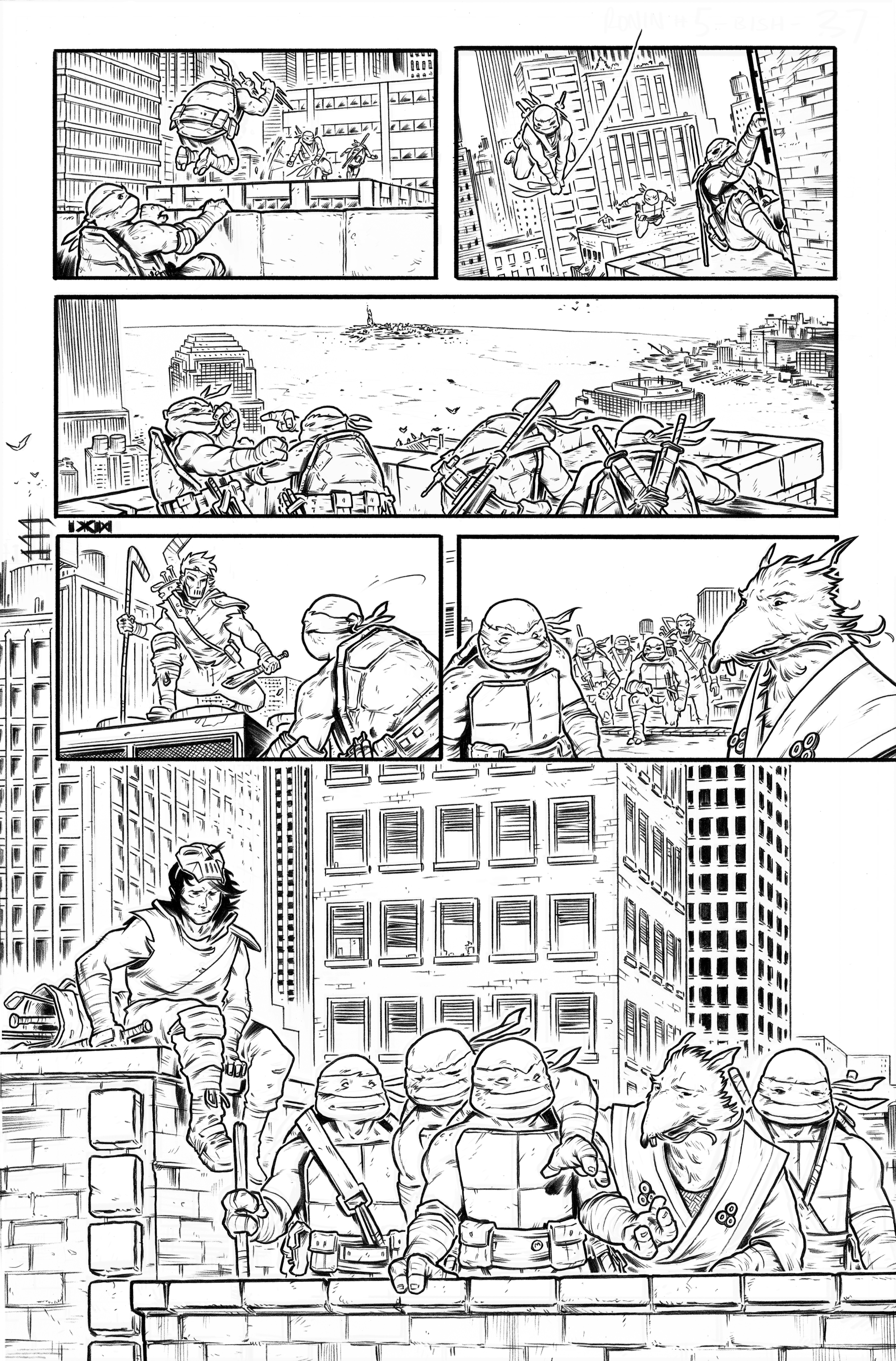
Completing The Last Ronin
Waltz: It took a lot longer than we thought, and everything that could happen on The Last Ronin pretty much did. But Kevin and I always thought everything happened for a reason with this book and that everything worked out the way it was supposed to. I think Kevin always knew this was an important story, but once we began working on it, I think it really hit him. The Last Ronin really became his grand opus.
Curnow: I don’t think Kevin would argue that the reason why The Last Ronin ended up taking so long was him. Yes, there was a pandemic with very real delays and complications, but Kevin wanted to get it right, and it was something he cared a lot about.
Waltz: Ultimately, it got done and the fans embraced it beyond our wildest expectations. We knew going in that it was going to be popular — we hoped it would be one of those books like Watchmen or V for Vendetta that are always on the shelf — but we didn’t expect what happened. IDW even got blamed for deliberately shorting the market on this book, but I assure you, they didn’t! They weren’t conservative with the print run at all and it still sold out beyond what we could imagine. The reaction from the fans has been huge. I mean, there are already toys coming out for The Last Ronin! That’s awesome!

Bishop: I think part of the reason the story was so successful was that it wasn’t done back in 1987. I was born in 1986. I grew up with the Turtles, and these characters have so much history and they mean a lot to the fans. The Last Ronin builds on that investment and tells a really effective, heart-wrenching story that is, once again, a comic book with Kevin and Peter on the cover, just like it was in the beginning.
Eastman: Putting together The Last Ronin was very similar to how Pete and I used to work — including it being late! The time was taken to make it perfect, and we really appreciate the fans being patient and sticking with us, as well as IDW and Nickelodeon for their patience.
Funny enough, the success of The Last Ronin has been similar to the success Pete and I felt back in 1984. Back then, we were surprised our comic actually sold and that we got to do more of them. For Tom and I on The Last Ronin, we hoped we could sell at least as much as the IDW ongoing series so that this book would at least cover its cost. We were completely blown away by how beloved and embraced it was.
It was the most difficult, challenging story I’ve done since those early days. And I could not be more ecstatic with the fans’ reactions. I'm quite humbled by the response. I just turned 60, and I’ve been able to draw Turtles for most of my life. Man, what a gift.







